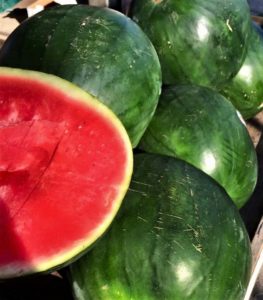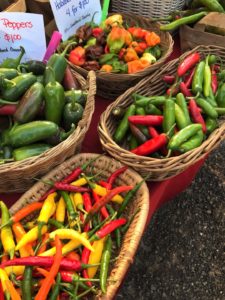The Watermelon Patch
By Tom Yates
My grandmother’s vegetable garden was a wonderland. Tucked inside white planked fencing covered with grapevines, rows and rows of vegetables flourished in the well plowed clay-packed soil of our western Kentucky farm. Meticulously attended to and lovingly cared for, her garden was a lush and harsh workhorse of a garden that provided fresh food for our family during the summer months and cellar provisions for the bleaker months. As a newly transplanted city-to-farm boy, I was the fetcher of the family. Tomatoes. Green beans. Corn. Potatoes. Summer squash. Zucchini. Onions. Beets. Carrots. I didn’t harvest. I fetched.

My grandfather’s watermelon patch, on the other hand, was a whole other story. Yards from the farmhouse and vegetable garden, the watermelon patch covered a large portion of a cow pasture. Surrounded by a single row of barbed wire to keep the cattle at bay, the patch was left mostly unattended through the long summer growing season, lying in wait for the August and September harvest. Out of sight and out of mind, dozens of watermelons were left to meander and grow through the dusty patch. If one split open from neglect, the wet beady seeds fell into the soil for the hovering hungry birds. As it wasn’t my charge, I didn’t tend to the watermelon field. I was the watcher. I knew their every move. I watched them grow, roam, ramble, roll, split, and sometimes rot. Most importantly, under my watchful eye, I knew when it was watermelon time.
We didn’t fuss over watermelons. They didn’t need to be prepped, processed, preserved, canned, put up, or cooked. They were simply grown for pleasure. We’d throw a few newspapers over an outdoor table, slice open a watermelon, chop it into wet wedges, slurp the sweet juices, spit the seeds, and drink in the long hot summer.
Right now, varieties of watermelon are hitting their stride. Summer might be waning, but there are still picnics, cookouts, barbecues, and tailgates to be had. Stop by a local farmers’ market and bring the watermelon patch home.
Watermelon plays well with others. Salty feta. Briny black olives. Cucumbers. Tomatoes. Basil. The sky’s the limit, really.
Thai Watermelon Salad.
Few things match the addictive mysterious tart and sweet umami of a Thai vinaigrette. Embrace the fish sauce. It’s transformative.

After dissolving 1 tablespoon light brown sugar into 5 tablespoons fresh squeezed lime juice, I added 1/4 cup fish sauce, 1/2 cup water, 2 minced garlic cloves, 1 teaspoon crushed fresh ginger, 3 thinly sliced Stonehedge multi-colored Thai bird chilies, Thai basil, purple basil, and fresh mint. I mixed the vinaigrette until combined and set it aside.
Chopped salted roasted peanuts. Check.
Thai basil. Check.
Sweet basil. Check.
Purple basil. Check.
Mint. Check.
Watermelon. Double check.

After slicing and sectioning a five-pound Pulaski County Sugar Baby watermelon, I removed the rind and sliced the firm flesh closest to the rind into 4″ by 1/2′ batons. I stacked the batons across each other Jenga-esque and drizzled the vinaigrette over the watermelon until it spilled through the crevices and puddled underneath. After splashing the melon with fresh lime juice, I finished with bits of crispy fried garlic, crunchy roasted peanuts, basil, mint, and additional chiles.
Simple. Fresh. Unexpected.
Find a watermelon patch. Quick. There’s still time.
____
This article also appears on page 16 of the August 2021 print edition of ace magazine.
Subscribe to the Ace e-dition for Lexington news, arts, culture, food, and entertainment news delivered to your inbox.
Call today to advertise in Ace, 859.225.4889








